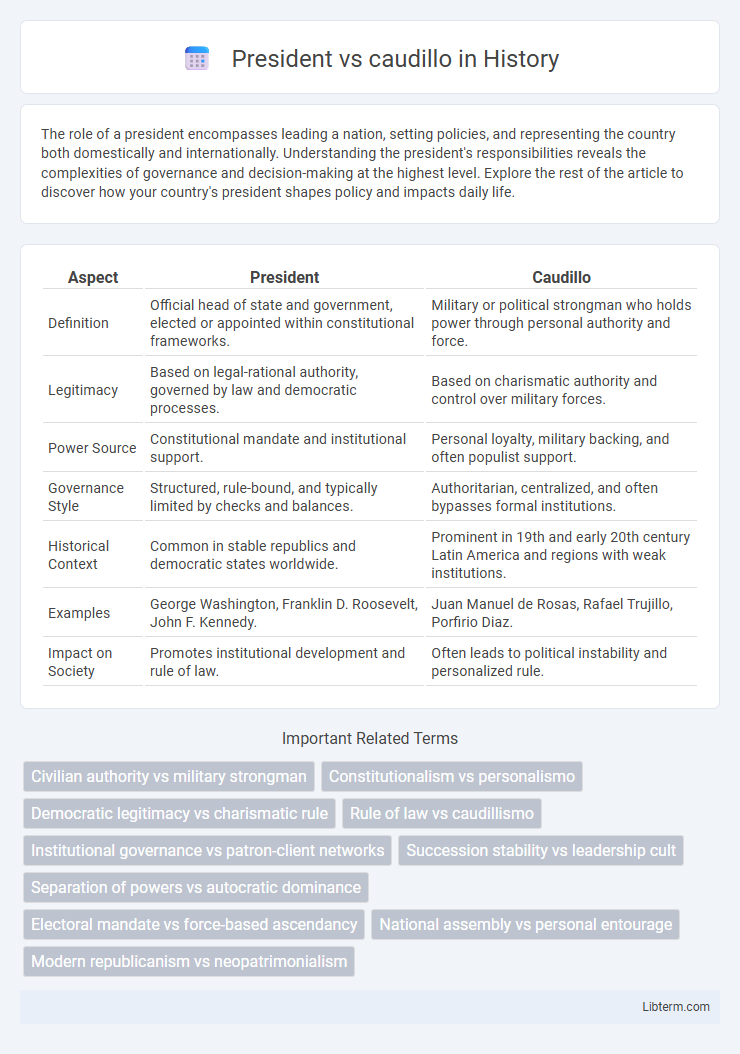The role of a president encompasses leading a nation, setting policies, and representing the country both domestically and internationally. Understanding the president's responsibilities reveals the complexities of governance and decision-making at the highest level. Explore the rest of the article to discover how your country's president shapes policy and impacts daily life.
Table of Comparison
| Aspect | President | Caudillo |
|---|---|---|
| Definition | Official head of state and government, elected or appointed within constitutional frameworks. | Military or political strongman who holds power through personal authority and force. |
| Legitimacy | Based on legal-rational authority, governed by law and democratic processes. | Based on charismatic authority and control over military forces. |
| Power Source | Constitutional mandate and institutional support. | Personal loyalty, military backing, and often populist support. |
| Governance Style | Structured, rule-bound, and typically limited by checks and balances. | Authoritarian, centralized, and often bypasses formal institutions. |
| Historical Context | Common in stable republics and democratic states worldwide. | Prominent in 19th and early 20th century Latin America and regions with weak institutions. |
| Examples | George Washington, Franklin D. Roosevelt, John F. Kennedy. | Juan Manuel de Rosas, Rafael Trujillo, Porfirio Diaz. |
| Impact on Society | Promotes institutional development and rule of law. | Often leads to political instability and personalized rule. |
Defining “President” and “Caudillo”: Key Distinctions
A president is a constitutionally elected head of state or government, often overseeing a democratic system with defined legal powers and term limits. In contrast, a caudillo is a military or political leader who typically gains power through force or populist support, ruling with personalist authority and minimal institutional constraints. The key distinction lies in the legitimacy and structure of authority: a president operates within formal legal frameworks, whereas a caudillo commands through charisma and authoritarian control.
Historical Origins of Presidents and Caudillos
Presidents originated from republican systems in the late 18th century, embodying democratic principles with elected authority and constitutional limits, beginning prominently with the U.S. in 1789. Caudillos emerged in 19th-century Latin America as charismatic military leaders who often seized power through force or popular support amidst political instability and weak state institutions. The historical contrast shows presidents as institutionalized heads of state versus caudillos as personalist rulers shaped by regional conflicts and civil wars.
Powers and Authority: Legal Limits vs. Personal Rule
Presidents typically operate within a defined constitutional framework that establishes legal limits on their powers, ensuring checks and balances through legislative and judicial oversight. Caudillos exercise authority based largely on personal rule, relying on charisma, military control, and patronage rather than formal legal constraints. The distinction lies in presidents' adherence to institutional norms versus caudillos' reliance on informal power networks and authoritarian control.
Democratic Institutions vs. Personalist Regimes
Democratic institutions emphasize the rule of law, separation of powers, and accountable governance through elected representatives, ensuring checks and balances that limit executive power. In contrast, personalist regimes under caudillos centralize authority in a single leader, often bypassing formal institutions and relying on patronage and military support to maintain control. This concentration of power undermines democratic processes, weakening institutions designed to uphold transparency and citizen participation.
Leadership Styles: Consensus-Building vs. Charisma
Presidents typically lead through consensus-building, relying on institutional frameworks and collaborative decision-making to achieve policy goals and maintain political stability. Caudillos, by contrast, depend on personal charisma and direct authority, often bypassing formal structures to enforce their will and command loyalty. This difference in leadership style shapes political dynamics, with presidents fostering inclusive governance and caudillos emphasizing centralized, charismatic power.
Legitimacy: Electoral Mandate vs. Popular Acclamation
Presidents derive legitimacy primarily through electoral mandates established by democratic elections, reflecting formal constitutional authority and institutional processes. Caudillos gain legitimacy via popular acclamation, relying on charismatic leadership and mass support often outside formal electoral systems. This distinction highlights the contrast between institutionalized political legitimacy and personalized, charismatic authority in governance.
Case Studies: Famous Presidents and Iconic Caudillos
Famous presidents such as Franklin D. Roosevelt and Abraham Lincoln exemplify democratic leadership focused on institutional governance and policy reform. In contrast, iconic caudillos like Juan Manuel de Rosas of Argentina and Porfirio Diaz of Mexico wielded personalist authority, often relying on military power and patronage networks to maintain control. These case studies highlight the fundamental differences between presidents as constitutional leaders and caudillos as authoritarian figures.
Impact on Political Stability and Governance
Presidents typically operate within formal constitutional frameworks that promote political stability through structured governance, rule of law, and institutional checks and balances. Caudillos often centralize power in personalist rule, leading to authoritarian governance that can cause political volatility due to weakened institutions and reliance on military or populist support. The contrast between presidential constitutionalism and caudillismo significantly affects the durability of political systems and effectiveness of governance in Latin American countries.
Legacy and Influence in Modern Politics
Presidents often leave a legacy rooted in institutional governance and democratic principles, shaping modern political systems through codified laws and policy reforms. Caudillos, in contrast, exert influence primarily through personal charisma and authoritarian control, affecting politics by concentrating power and sometimes undermining institutional stability. The enduring impact of presidents tends to promote political continuity, while caudillos often inspire populist movements and challenge the legitimacy of formal democratic structures.
The Future: Evolving Roles in Contemporary Leadership
President and caudillo roles continue to diverge as modern governance emphasizes institutional accountability and democratic principles over personal authority. Contemporary leadership trends show presidents adopting collaborative decision-making and policy transparency, contrasting with the caudillo's legacy of centralized, charismatic power. Future political landscapes will likely reinforce constitutional checks, diminishing the influence of caudillo-style leadership in favor of structured presidential governance.
President Infographic

 libterm.com
libterm.com